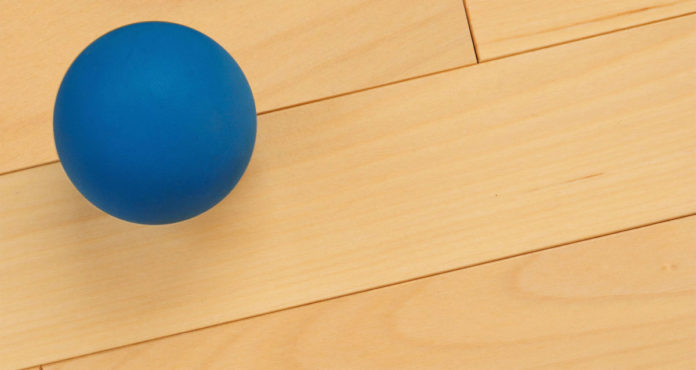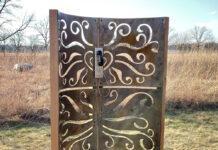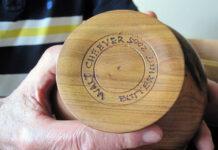If you sat down to coffee with MSU-Mankato graduate student Ciana Ni Churraoin you’d immediately notice that she isn’t a typical, local college kid thanks to her low and lilting Irish accent. Once the conversation picked up, though, it’d be easy to discover just how un-typical she is—as soon as she started passionately discussing the sport of handball.
You see, Ni Churraoin (pronounced Knee-Cureen) is a handball fanatic, and not just from the spectator side of things. She’s currently ranked as the No. 2 female handball player in the world.
Handball, in case you are unaware, is a sport where players use their hands to hit a small rubber ball against a wall, trying to earn points by ensuring that their opponent can’t do the same thing without hitting the ball twice.
“It’s kind of one of those sports that you’re addicted to it, or you know nothing about it,” Ni Churraoin said. “I got into it, and became very involved, and never looked back.”
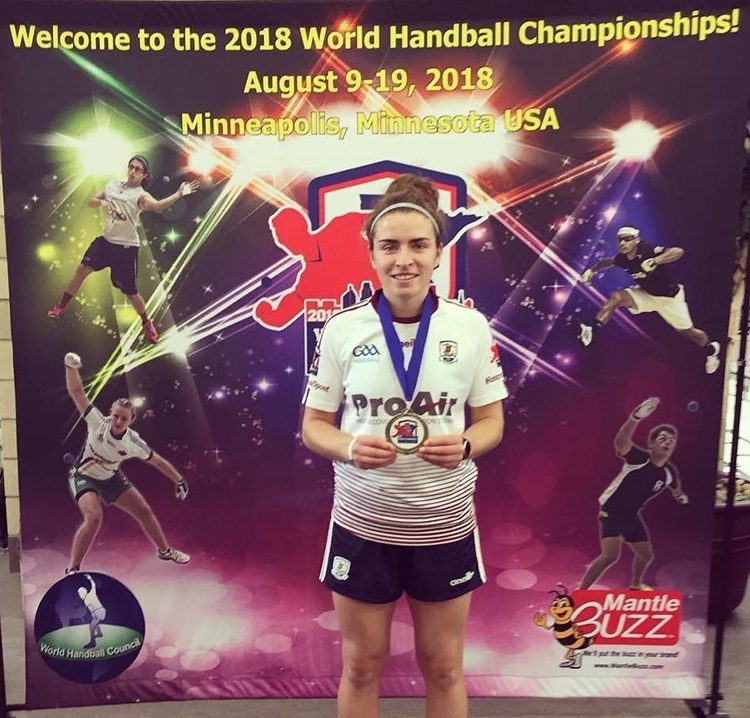
In fact, Ni Churraoin’s love of handball is how she ended up in a graduate program in snowy Minnesota, since MSU-Mankato has a surprisingly competitive handball team. Now, Ni Churraoin splits her time between the classroom and the court, and she says handball has given her much more than just bragging rights as one of the world’s top players.
“Handball has given me so much in terms of friends, and even coming here,” she said. “I would never have had the opportunity to come here if I didn’t play handball.”
Starting Young
Ni Churraoin grew up in Galway, Ireland and began playing handball—one of the most popular sports in that country—when she was 7. She said she first became interested because her older brother played the sport.
“He’s four years older than me, so at the time, anything he did, I wanted to do,” she said with a chuckle. “I would tag along when he and his friends would go to play, and I’d just watch. Then the coach there said, ‘Maybe you should come to one of the trainings.’ My mom thought I was too young, but I begged her to let me go. So that’s basically how I got started.”
Ni Churraoin also played Gaelic football (similar to soccer, though players are allowed to use their hands for certain moves) and hurling (which is also similar to soccer but uses hand-held sticks to move the ball around), two other popular Irish sports. In the beginning, she played on the boys’ team for all three sports because there weren’t strong girls’ teams in the area, but she eventually had to join girls’ teams when she was 15, according to local rules.
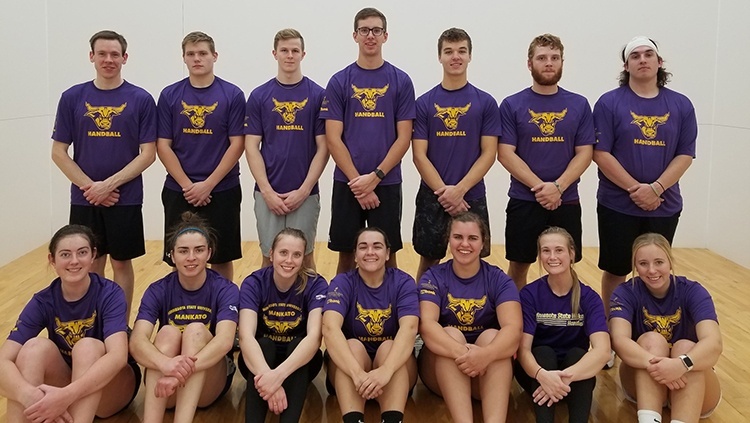
When Ni Churraoin was 13, she competed in the Junior Nationals (now known as the All-Ireland Championship) and took first place in her category, the Under 15 division. Because of this, she earned a spot on the touring Irish team, which traveled to the U.S. to compete in Chicago during the U.S. Nationals. The team had six players, three boys and three girls, along with two coaches, and spent 10 days during the Christmas season in the U.S.
Ni Churraoin said she didn’t even know earning a spot was an option as she played during the Junior Nationals and was only informed of the opportunity after she beat her opponent in a “really intense” tiebreaker round.
“I couldn’t believe it,” she said. “That was an amazing trip. The next year my goal was to get on the Irish team and travel again, but then I lost. But the first time I got to travel with the Irish team, I still remember it, even though it was 10 years ago. You basically stay in a hotel with all your friends, because you become really close with those people because you’re traveling with them.”
Ni Churraoin added that the trip was her first time away from home on Christmas, though it was still fun because she and her teammates participated in a Secret Santa exchange. Even better, they all ended up coming in first in their divisions during the U.S. Nationals.
It’s kind of one of those sports that you’re addicted to it, or you know nothing about it. I got into it, and became very involved, and never looked back.
“It was a successful trip for us,” she said. “I think the whole experience of being on the Irish team was huge for me.”
Ni Churraoin continued to travel for her sport. When she was 18, she began traveling on the handball “pro tour,” which features different stops for tournaments in the U.S. throughout the year. For women, there are three stops, with the tournaments taking place over a weekend. Players receive “ranking points” based on how they finish, which is how Ni Churraoin eventually earned enough to snag the No. 2 spot this year.
Players who earn top ranking spots often receive incentives from the IHF, such as funds for their travel. Before Ni Churraoin was able to carve out a place for herself, though, she said her parents helped her by supporting her trips.
“Luckily, my parents are just really supportive of me playing sports,” she said. “My parents have always supported me and helped me travel to become the player that I want to be. To be honest, but for them, I probably wouldn’t have been able to travel.”
A Short Sideline
Ni Churraoin continued to play all three of her sports until she was 20, but became more difficult to fit everything in once she began attending the University of Limerick in 2014. She studied both physical education and Irish language teaching (in Galway, the first language is Gaelic, so Ni Churraoin is fluent in that and English), with the plan of becoming an Irish language teacher once she graduated.
Because of her tighter schedule, Ni Churraoin eventually stopped playing Gaelic football and hurling and instead really focused on handball. She still played the other sports for fun with her hometown club, but she didn’t compete on a higher level.
Unfortunately, during one of those “fun” games of Gaelic football, Ni Churraoin injured her ACL—a career-derailing injury.
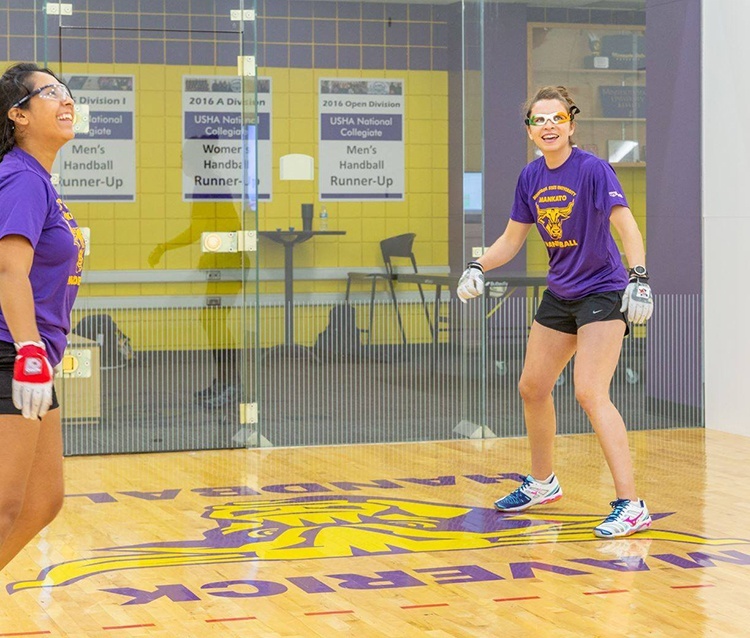
“I was on the field, and my body turned and my knee did not,” Ni Churraoin said ruefully. “That was the biggest challenge I faced in terms of my sports. I had to wait six weeks after injury for the surgery, and it was another nine months of recovery after that.”
The injury happened in May 2017, and Ni Churraoin started months of physical rehab afterwards. Her goal was to heal enough to compete in the IHF (International Handball Federation) World Handball Championship in August 2018. She wasn’t cleared to play until March 2018, though, which left precious little time to train and prepare for the event.
But Ni Churraoin not only healed well enough to participate—she ended up winning in her division (the Under 23 category). She also played in the open grade division, which anyone can participate in, and managed to make it to the semi-finals.
“I was initially very disappointed when I lost, but then reflecting on it, I was like, ‘You haven’t played in a year and a half, so that’s pretty solid,’” Ni Churraoin said.
Experiencing Something New
It was during Ni Churraoin’s time at the University of Limerick that she learned about MSU’s handball team. The university’s handball coach, Dr. Michael Wells (who also teaches in the MSU Technology Department), had come to Ireland to try to recruit more international players for his blossoming team. He told her about MSU’s master’s program in Sport and Exercise Psychology, pointing out that she’d have a chance to study one of her interests while still playing handball.
At the time, Ni Churraoin was still in her junior year and hadn’t injured her ACL yet, and she wasn’t sure about traveling to the U.S. to continue her studies.
“I was like, ‘No, I have a full year,’” she recalled, “but he explained that the process can take a while. So, I started looking into it. I applied, and honestly, I didn’t really think about it. I wasn’t like, ‘I’m going to the U.S.’ Then the professors called me for an interview, and then after the phone call, I was like, ‘Oh my God, I actually might be going.’”
Ni Churraoin said she was interested in coming to MSU-Mankato because she had always enjoyed studying sports science as an undergraduate, and moving to the U.S. would make it easier for her to attend Pro Tour tournaments. Once she was accepted into the program in early 2018, she decided to take the plunge and go for it.
“It was kind of annoying that I’d [injured] my ACL [during the application process], because there was the uncertainty of, ‘Will I actually be able to play while I’m there?’” Ni Churraoin recalled. “While I was really interested in doing the program, another huge thing for me was to be able to play handball here. They kind of went hand in hand. And thankfully it worked out.”
A Different Arena
Ni Churraoin started attending MSU-Mankato in the fall of 2018. She splits her time between her courses and her position as a graduate assistant for the MSU Center for Sport and Performance Psychology. There, she mentors undergraduate students, assists faculty members and helps plan and coordinate the University’s athletic outreach programs to area elementary and high school students.
Of course, one of Ni Churraoin’s top priorities is still handball. She participates on MSU’s Maverick team, which has about 20 players. In mid-February of this year, the team traveled to Texas to participate in the U.S. Handball Association’s 68th National Collegiate Handball tournament, where the combined Maverick team finished runner-up. The Lady Mavericks female team also finished runner-up in the national. Meanwhile, Ni Churraoin became the women’s open champion for the second year in a row, as well as also earning All-American honors for the second straight year.
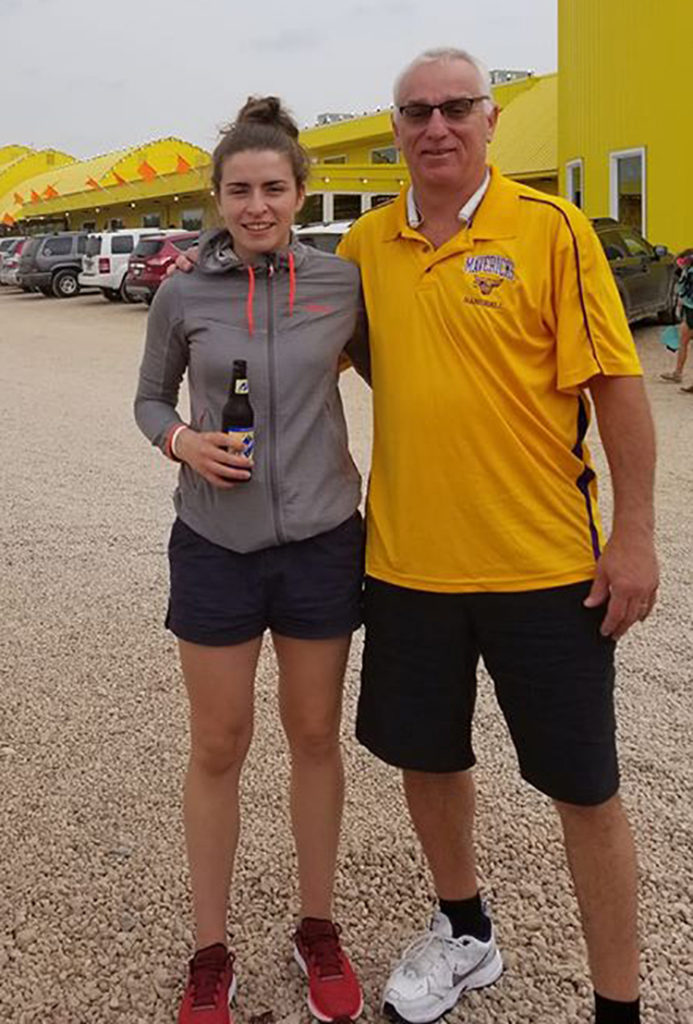
Ni Churraoin also helps coach the team and mentors younger players who want to grow in their handball abilities. She works with college students and high school students in the area.
In addition to her time on the court, Ni Churraoin also keeps herself in playing condition through daily training sessions that tend to revolve around CrossFit-type exercises. She explained that these are especially good for handball players, since the game tends to be broken up into intense 30-second intervals, followed by short rest periods. She also tries to play at least three games a week, against teammates or Wells, in addition to the team’s weekly practices.
“I do a lot of individual training, like practicing skills and going back to basics,” she said. “There’s no magic trick to it; you just have to do the little things every day.”
Future Plans
Once Ni Churraoin graduates, she hopes to obtain her Optical Practical Training (OPT) visa, which would allow her to stay in the U.S. for up to one year to work in her field of study. She explained that the sport psychology field is much broader in America than in Ireland.
“I’d like to gain experience here in the field,” she said. “In gaining experience here, I feel like I could go home and start my own thing, and I feel like that’s what I’d probably have to do in moving back to Ireland because there’s no specific job in sports exercise psychology.”
Eventually, Ni Churraoin wants to move back to Ireland and perhaps set up her own sports psychology clinic, which would allow her to use the skills she has learned to help other athletes.
“In recent years, a lot of [Irish] players have been opening up about struggles about dealing with different issues,” she said. “I think there’s a huge gap there in terms of providing services to these players and helping them understand that they can use their own minds to help better their performance on and off the field. That’s just something I think I could hopefully help some people with in the future.”
Of course, no matter what Ni Churraoin ends up doing, she is committed to reserving a space for handball—a sport that she highly encourages everyone to try.
“It really is a sport for anyone,” she said. “There’s a division for everyone you can possibly imagine. You don’t even have to compete; it’s just a great full body workout. You can choose to make it fun or you can choose to make it competitive, and you’ll find someone who’s the same level as you. You don’t have to be a superstar; you can just do your thing. Everyone in handball has something weird about them, so I wouldn’t be worried about fitting in. That’s a joke we have… there’s something about everyone in handball that makes them fit into this world. I just think there’s a space for everyone there.”
Getting to Know Ciana
Age: 23
From: Galway, Ireland
Lives in: Mankato
Studying: Sport and Exercise Psychology at MSU-Mankato
Hobbies: Trying new foods, anything to do with Harry Potter, exercising
Bucket destination to visit before she leaves the U.S.: Miami. “I have a goal of living somewhere warm right now. When I say it’s -30 degrees Celsius, everyone at home is like, ‘How are you actually alive in that cold?’ It’s been quite the experience. I’m ready to live somewhere with a nicer climate.”
Is she better at handball now than her brother?: “He’ll be mad, but yes.”
A Different Side of the Game
According to Ni Churraoin, playing handball in the U.S. has been an interesting experience, since Ireland tends to focus more on the individual side of the game and the U.S. tends to focus more on the team aspect.
“There is a focus on playing for your club in handball in Ireland, but it’s also very individualistic,” she explained. “You compete in the tournament, and you want to win that title. And obviously you want to do that here too, but there’s also an aspect of winning points for your team. So at the Nationals, it’s a huge thing to win the combined teams event. There’s a huge focus on that team aspect, whereas at home, it’s more so like you go to the tournament and compete, and you wear your club jersey, but you want to win [on a personal level].”
She added that working with the MSU team, and especially coach Mike Wells, has helped her improve her own game.
“It’s been great to work with new people because you just get a different perspective on your game,” she said. “Some things that Mike would use in his game, I never would have thought of implementing in my game, like different kinds of serves and different drills that I can do to improve different aspects.”
Handball Basics
Handball (known as just handball in the U.S. and American handball in Europe) is a sport where players use their hands to hit a small rubber ball against a wall in an enclosed court. The sport can be played on an individual level (singles) or in teams of two (doubles), with four-wall, three-wall and one-wall versions.
Players take turns serving the ball. During a serve, the ball must pass over the “short line” in the middle of the court but not go past the “long line” that marks the out-of-bounds area. It can bounce once before hitting the wall (or not at all), and then it’s the other player’s turn to retrieve it, which must be done by hitting the wall before it bounces on the floor more than once. Otherwise, the scorer receives one point. (Only the player serving can earn a point in a turn.) The play stops when the ball is hit out of bounds or touches the floor before it touches the wall. Whoever is serving continues to serve until they don’t receive a point.
Games can finish at different scores, such as 11 or 21. According to Ni Churraoin, games are played to 15 at pro stops, with Nationals going to 21 points. Games are best two out of three, and they last an average of 30 minutes each, depending on how matched the players are.

